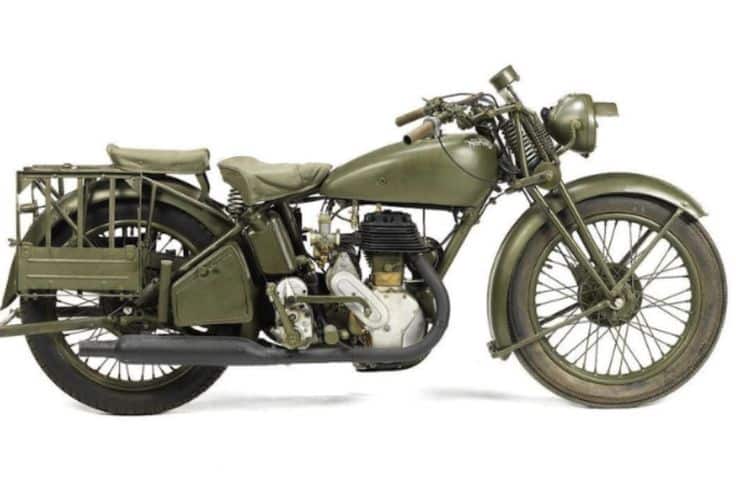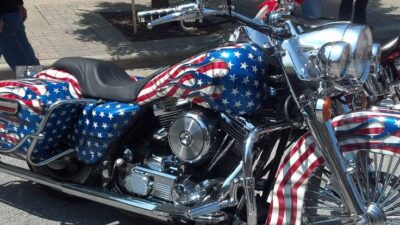World War II transformed motorcycles from simple transportation into essential military tools that shaped battlefield tactics and communication strategies. Military forces across all theaters relied on these versatile machines for reconnaissance, message delivery, and rapid troop movement in situations where larger vehicles proved impractical.

Motorcycles served critical roles as messenger vehicles, reconnaissance platforms, and mobile weapons carriers, with innovations like reinforced frames and improved suspension systems that emerged from wartime demands. The war drove rapid technological advances as manufacturers developed purpose-built military models with enhanced durability, standardized parts, and specialized features like sidecar mounts for machine guns.
Major powers including Germany, Britain, Japan, and the United States deployed iconic motorcycle models throughout the conflict, from the German BMW R75 and Zündapp KS 750 to the American Harley-Davidson WLA and British Norton series. These wartime developments created lasting impacts on motorcycle design that influenced civilian models for decades after the war ended.
Key Takeaways
- Military motorcycles provided essential battlefield mobility for reconnaissance, communication, and rapid troop deployment during World War II
- Wartime engineering advances like reinforced suspensions and rugged frames carried over to civilian motorcycle production after the conflict
- Over 90,000 motorcycles were produced during the war with models serving across multiple theaters from Europe to the Pacific
Key Roles of Military Motorcycles in World War II

Military motorcycles served as essential tools across multiple battlefield functions during World War II. They excelled in reconnaissance missions, communication networks, supply transport, and direct combat support operations.
Reconnaissance and Communication
Motorcycles proved invaluable for reconnaissance and courier duty throughout World War II. Military commanders relied on motorcycle scouts to gather intelligence on enemy positions and troop movements.
The speed and agility of motorcycles made them perfect for delivering urgent messages between units. Telegraph lines were vulnerable to enemy attacks, making motorcycle messengers critical for maintaining communication.
Key Communication Roles:
- Message delivery between command posts
- Intelligence gathering behind enemy lines
- Coordination between advancing units
- Emergency communications when radio systems failed
Most Harley-Davidson motorcycles were legendary WLA models assigned to reconnaissance work. These bikes could navigate rough terrain that wheeled vehicles couldn’t traverse.
Motorcycle dispatch riders often operated alone or in small groups. This reduced their visibility to enemy forces while maintaining communication networks across battle zones.
Logistics and Transport Duties
Military motorcycles served in various missions including sending munitions and supplies. Sidecar-equipped motorcycles significantly increased carrying capacity for essential supplies.
Military police units extensively used motorcycles for patrolling base areas and secured zones. The mobility allowed quick response to security threats across large military installations.
Transport Applications:
- Medical evacuation with stretcher sidecars
- Ammunition delivery to forward positions
- Equipment transport in difficult terrain
- Military police patrol duties
German forces deployed specialized models like the BMW R75 with reverse gear and differential locks. These features enabled operation in extreme conditions where trucks couldn’t function effectively.
Motorcycles required less fuel than larger vehicles while maintaining operational flexibility. This fuel efficiency proved crucial during supply shortages in extended campaigns.
Combat Support and Tactical Operations
Motorcycles maintained important roles in special forces and rapid-response missions, especially in rough terrain. Fast-moving motorcycle units could quickly reposition during fluid battle situations.
Combat engineers used motorcycles to rapidly assess bridge conditions and road obstacles. The quick deployment capability supported advancing infantry and armored units.
Tactical Advantages:
- Quick deployment of specialist personnel
- Rapid battlefield repositioning
- Support for advancing infantry units
- Emergency response capabilities
Military motorcycles were valued for their agility and ability to navigate rough terrain. This mobility made them essential for reconnaissance missions in contested areas.
Motorcycle units often served as advance scouts for larger formations. They provided early warning of enemy positions and identified safe routes for following forces.
Technological Innovations and Engineering Advances

World War II drove rapid improvements in motorcycle design and manufacturing. Military needs pushed engineers to develop more reliable engines, better suspension systems, and standardized parts that could be easily maintained in combat zones.
Engine and Drivetrain Improvements
The war demanded motorcycles with greater reliability and fuel efficiency. The BMW R75 featured a sophisticated 750cc boxer engine that delivered consistent power across different terrains and weather conditions.
This German machine used a unique drivetrain system. It included a differential and reverse gear, making it highly maneuverable in tight spaces.
American manufacturers focused on simplicity and durability. The Harley-Davidson WLA used a proven 750cc V-twin engine that soldiers could maintain with basic tools.
British engineers took a different approach with the BSA M20. Its 500cc single-cylinder engine prioritized fuel economy over raw power. This design proved ideal for reconnaissance missions where long range mattered more than speed.
Key engine improvements during WWII:
- Enhanced air filtration systems for dusty conditions
- Improved cooling systems for desert operations
- Strengthened internal components for heavy loads
- Better fuel delivery systems for reliability
Suspension and Off-Road Capabilities
Military motorcycles needed to handle rough terrain that would destroy civilian bikes. The BMW R75 pioneered advanced suspension technology with its telescopic front forks and plunger rear suspension.
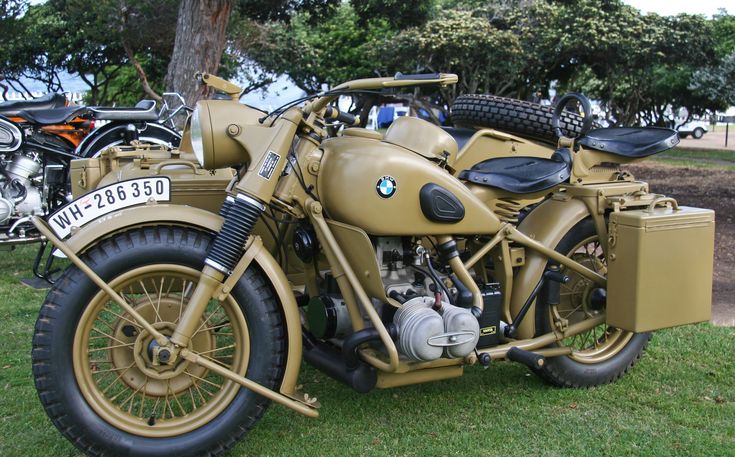
This suspension system allowed the bike to carry heavy loads while maintaining stability. The R75 could handle a sidecar, passenger, and equipment weighing over 400 pounds.
The military influence on motorcycle design extended to tire development. Engineers created new tread patterns for mud, sand, and snow conditions.
British and American bikes used simpler suspension designs. The BSA M20 and Harley-Davidson WLA featured rigid rear frames with spring saddles. While less advanced, these systems were easier to repair in field conditions.
Off-road improvements included:
- Wider, knobby tires for better traction
- Higher ground clearance
- Reinforced frames to prevent cracking
- Waterproof electrical systems
Field Maintenance and Standardization
Military operations required motorcycles that soldiers could fix quickly with limited tools. The Harley-Davidson WLA became famous for its simple maintenance requirements.
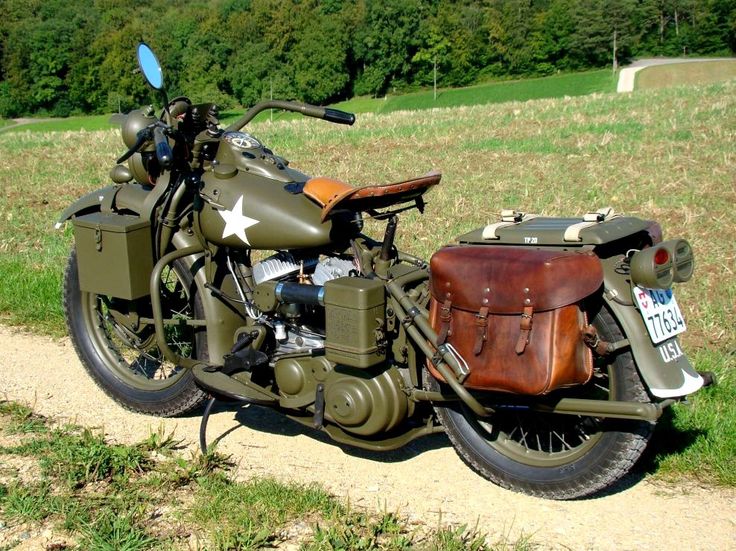
Standard parts across different models made repairs easier. The WLA shared many components with civilian Harley models, ensuring parts availability.
The BSA M20 used a modular design approach. Its engine, transmission, and electrical components could be swapped between bikes in the field. This interchangeability saved time and resources.
German engineers created detailed field manuals for the BMW R75. These guides showed soldiers how to perform complex repairs using portable tool kits.
Standardization efforts included:
- Common bolt sizes across different systems
- Universal tool requirements
- Simplified electrical systems with fewer components
- Modular parts that fit multiple bike models
The war pushed manufacturers to create maintenance schedules that extended bike life. Regular service intervals prevented breakdowns during critical missions.
Iconic Military Motorcycle Models

Three motorcycle models dominated World War II battlefields through superior engineering and battlefield adaptability. The BMW R75 showcased German technical innovation, the BSA M20 provided reliable British military transport, and the Harley-Davidson WLA became America’s most recognized wartime motorcycle.
BMW R75 and German Engineering
The BMW R75 became a symbol of German engineering during World War II. Development began in the late 1930s at the Wehrmacht’s request.
This heavy motorcycle featured a 745cc flat-twin engine with an innovative drive system. The R75 powered both the rear wheel and sidecar wheel, offering superior off-road performance.
Key Technical Features:
- Reverse gear for tight maneuvering
- Locking differential system
- All-terrain capability
- Standardized sidecar attachment
The BMW R75 saw extensive action on the Eastern Front and North Africa Campaign. Desert conditions required design modifications, including changing metal fork covers to rubber ones.
German forces sometimes mounted MG 34 machine guns on the sidecar. This gave the R75 firepower that other motorcycles lacked. Mobile infantry units within the Wehrmacht and SS used these armed versions effectively.
BSA M20 and British Contributions
The BSA M20 served as Britain’s primary military motorcycle throughout World War II. This single-cylinder 496cc machine prioritized reliability over performance.
British forces valued the M20’s simple design and easy maintenance. The motorcycle could operate in harsh conditions with minimal mechanical issues.
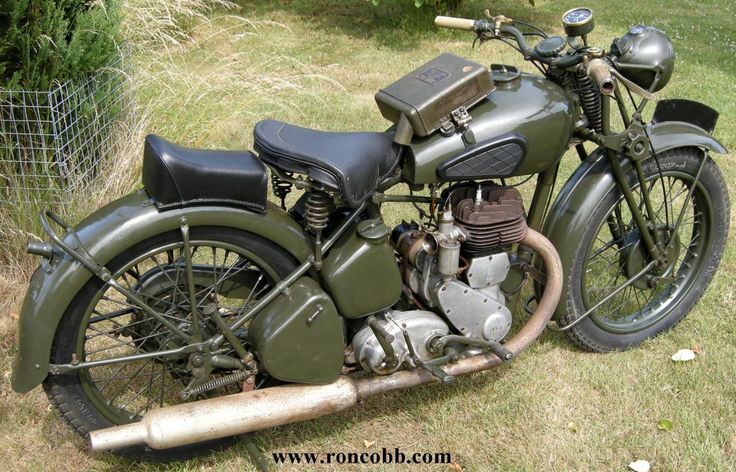
M20 Specifications:
- Engine: 496cc single-cylinder
- Power: Approximately 13 horsepower
- Weight: 350 pounds
- Top Speed: 55 mph
The M20 performed multiple battlefield roles. Dispatch riders used it for communication between units. Military police employed it for convoy duties and base security.
Commonwealth forces adopted the M20 across multiple theaters. It served in North Africa, Europe, and the Pacific campaigns. The motorcycle’s rugged construction suited tropical and desert environments equally well.
Harley-Davidson WLA in the U.S. Military
The Harley-Davidson WLA earned the nickname “the Liberator” and became America’s most famous wartime motorcycle. Production ran from 1940 to 1952, with over 90,000 units manufactured.
The WLA featured a 45 cubic inch V-twin engine producing about 26 horsepower. Military modifications included special paint, reinforced fenders, and waterproofing for river crossings.
Military Modifications:
- Blackout lighting systems
- Military-spec air cleaner
- Enhanced fording capabilities
- Reinforced accessories mounting
U.S. Army units used the WLA for escort duties, police work, and reconnaissance missions. Dispatch riders carried radio equipment and urgent communications between battlefield positions.
The Soviet Red Army received modified WLA variants through Lend-Lease programs. These versions included sidecars for additional personnel or equipment transport. American paratroopers also used the WLA in European operations during the war’s final stages.
Comparison with Other Military Vehicles

Military motorcycles served unique roles that distinguished them from jeeps and other vehicles, while specialized sidecar configurations expanded their tactical capabilities. These two-wheelers filled specific gaps in military operations that larger vehicles could not address.
Motorcycles vs. Jeep: Complementary Roles
Motorcycles and jeeps served different but complementary functions during World War II. Motorcycles proved useful for messenger and reconnaissance duties, especially in fast-moving formations where speed and maneuverability mattered most.
Key advantages of motorcycles:
- Lower fuel consumption than jeeps
- Better navigation through narrow paths
- Quieter operation for covert missions
- Faster acceleration and top speeds
Jeep advantages over motorcycles:
- Greater cargo capacity
- Better protection from weather and enemy fire
- More stable platform for weapons
- Ability to carry multiple personnel
The jeep eventually replaced some motorcycle roles due to its versatility. The Norton WD Big 4 was ultimately replaced by the Willys Jeep as military needs shifted toward vehicles that could carry more equipment and personnel.
Motorcycles and Sidecars for Specialized Missions
Sidecar-equipped motorcycles created unique tactical platforms that bridged the gap between solo motorcycles and larger vehicles. The BMW R75 featured an innovative drive system that powered both the rear wheel and sidecar wheel, offering superior off-road performance.
German forces extensively used sidecar motorcycles for specialized roles. The BMW R75 was sometimes mounted with an MG 34 machine gun, giving it firepower that regular motorcycles lacked.
Sidecar motorcycle capabilities:
- Weapons platforms: Could mount machine guns or mortars
- Communication hubs: Carried radio equipment between positions
- Supply transport: Hauled ammunition and supplies to front lines
- Medical evacuation: Transported wounded soldiers from battlefield
The sidecar design allowed for two-person operation while maintaining motorcycle mobility advantages. This configuration proved especially valuable on the Eastern Front and in North Africa campaigns.
Impact on Military Strategy and Effectiveness

Military motorcycles transformed World War II combat operations through enhanced mobility and communication capabilities. These machines enabled commanders to execute faster troop movements and maintain critical battlefield coordination that often determined victory or defeat.
Tactical Mobility and Rapid Deployment
Motorcycles proved essential for fast-moving military formations during World War II operations. Their speed and maneuverability allowed units to redeploy quickly across different terrain types.
German forces used motorcycles extensively during blitzkrieg operations. These machines enabled rapid advances through Poland, France, and the early stages of the Russian campaign.
Key tactical advantages included:
- Quick reconnaissance missions behind enemy lines
- Rapid message delivery between command posts
- Fast patrol operations along extended front lines
- Efficient supply line monitoring
American forces deployed motorcycles for patrolling, communication duties, and reconnaissance missions across multiple theaters. The machines performed effectively in European forests, Pacific jungles, and North African deserts.
Motorcycle units could cover 200-300 miles per day compared to 20-30 miles for infantry divisions. This speed difference changed how commanders planned operations and allocated resources.
Influence on Battlefield Outcomes
The speed and capacity of motorcycles to relay information made them indispensable military tools. Communication networks built around motorcycle messengers often determined battle success or failure.
Radio equipment frequently failed in combat conditions. Motorcycle dispatch riders provided reliable backup communication when electronic systems went down.
Critical battlefield contributions:
- Coordinated artillery strikes through rapid message delivery
- Enabled real-time intelligence sharing between units
- Maintained command structure during chaotic combat situations
- Supported complex multi-unit operations requiring precise timing
Soviet forces used motorcycles to coordinate defense operations during the siege of Stalingrad. Quick communication helped Soviet commanders respond to German attacks and organize counteroffensives.
Pacific theater operations relied heavily on motorcycle reconnaissance. These missions provided crucial intelligence about Japanese positions and troop movements across island battlefields.
The machines allowed smaller forces to achieve strategic objectives previously requiring larger infantry units. This efficiency freed up personnel for other critical military roles.
Post-War Legacy and Influence on Motorcycle Design

World War II motorcycles transformed civilian transportation and sparked new cultural movements when veterans returned home. The technological advancements made during the war became the foundation for modern motorcycle design and manufacturing.
Civilian Adoption and Motorcycle Culture
Returning GIs with military motorcycle experience wanted more than basic transportation after the war. Many veterans had operated reliable machines like the Harley-Davidson WLA and BSA M20 during combat.
These soldiers began modifying their motorcycles for performance and style. They stripped off unnecessary parts and added custom elements to create faster, lighter bikes.
World War II motorcycles helped transform post-war motorcycle culture in America. Veterans formed riding groups that eventually became organized motorcycle clubs.
The customization movement grew rapidly in the 1940s and 1950s. Riders shared techniques for improving engines, suspension, and styling based on military motorcycle knowledge.
Enduring Innovations in Modern Motorcycles
War-time engineering advances shaped civilian motorcycles for decades. The BMW R75 introduced sophisticated features like shaft drive and advanced suspension systems that manufacturers adopted widely.
Improved engine designs and suspension systems from WWII made civilian motorcycles safer and more reliable. These innovations created more powerful machines for everyday riders.
Military demands pushed advances in suspension, off-road tires, and lighting systems that became standard features. Modern dual-sport motorcycles trace their design directly to wartime reconnaissance bikes.
Manufacturing processes improved significantly during wartime production. Mass production techniques developed for military contracts allowed companies to build better civilian motorcycles at lower costs after 1945.
Frequently Asked Questions

Motorcycles served crucial messenger and reconnaissance roles during the war, with major innovations in engine design and military adaptations. The Harley-Davidson WLA dominated Allied forces while German BMW and Zündapp models featured advanced sidecar systems and superior off-road capabilities.
What were the primary functions of motorcycles during World War II?
Motorcycles served as essential communication tools for military forces. Messenger and reconnaissance troops relied heavily on these vehicles in fast-moving formations.
The vehicles transported radio equipment between positions. They also carried weapons and ammunition to forward operating areas.
Convoy marshaling and dispatch riders used motorcycles extensively for coordination. Scouting operations depended on their speed and maneuverability.
Some models served combat roles when fitted with machine guns. The German forces mounted MG 34 machine guns on BMW R75 motorcycles with sidecars.
Which innovations in motorcycle technology emerged during World War II?
Military specifications drove major engineering advances during the conflict. Engines became more reliable and powerful to meet battlefield demands.
Specialized military features appeared on wartime models. These included blackout lighting systems, reinforced frames, and improved air filtration for dusty conditions.
Sidecar technology advanced significantly during the war. German manufacturers developed two-wheel drive systems that powered both the rear wheel and sidecar wheel.
Foldable motorcycle designs emerged for airborne operations. The British Welbike could be dropped by parachute and assembled quickly by paratroopers.
What models of motorcycles were commonly used by Allied forces during the conflict?
The Harley-Davidson WLA dominated American forces throughout the war. Known as “the Liberator,” over 90,000 units were produced between 1940 and 1952.
British forces relied on Norton motorcycles extensively. The Norton WD16H served as the primary British Army motorcycle, with factories producing up to 500 units weekly.
The Norton WD Big 4 provided heavier-duty capabilities. This model featured a 633cc engine and was designed specifically for sidecar operations.
Cushman Airborne Scooters appeared in 1944 for American paratroopers. Nearly 5,000 units were manufactured by war’s end.
How did World War II motorcycle design influence post-war civilian models?
Military reliability standards carried over to civilian production. Manufacturers applied wartime durability improvements to peacetime models.
Engine technology developed for military use improved civilian motorcycles. Better air filtration and cooling systems became standard features.
Design simplicity from military models influenced post-war aesthetics. Clean lines and functional styling replaced ornate pre-war decorations.
Mass production techniques refined during wartime reduced civilian motorcycle costs. This made motorcycles more accessible to average consumers after 1945.
What were the significant differences between German motorcycles and those of the Allies?
German motorcycles featured superior sidecar integration and all-terrain capabilities. The BMW R75 and Zündapp KS 750 both used two-wheel drive systems for better traction.
Allied motorcycles prioritized simplicity and mass production. American and British models focused on reliability rather than advanced features.
German designs emphasized combat applications. Motorcycles incorporated machine gun mounts and armor protection for crew members.
American forces used motorcycles primarily for support roles rather than direct combat. This influenced their simpler, more utilitarian designs.
In what ways did motorcycles contribute to military tactics and logistics in World War II?
Fast communication networks depended on motorcycle messengers. Radio equipment was often unreliable, making human couriers essential for command coordination.
Mobile reconnaissance units used motorcycles for intelligence gathering. Their speed allowed rapid movement between observation points without detection.
Supply operations relied on motorcycles for last-mile delivery. They could navigate narrow roads and rough terrain that larger vehicles couldn’t access.
Specialized units like German Kradschützen Truppen used motorcycles for rapid deployment. These mobile infantry forces could quickly respond to changing battlefield conditions.
